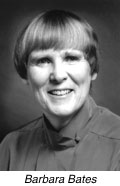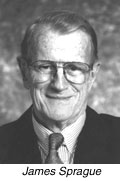
|
Deaths Barbara Bates | Milton Cahn | James Sprague
Dr. Barbara Bates, former clinical professor of nursing, who achieved recognition for writing the leading textbook on physical examination and for conceiving and developing the nurse practitioner profession, died December 18, at the age of 74 of Alzheimer's at her home in Bryn Mawr. She began teaching here in 1980 as an adjunct professor of nursing, she was a lecturer in nursing and in medicine, 1983-94, and she was a clinical professor of nursing, 1994-96. She was also a clinical professor of medicine at MCP and Hahnemann University, 1994-96. A native of Auburn, NY, Dr. Bates earned her B.A. at Smith College in 1949, then completed medical studies and residency training at Cornell University Medical College in New York City. She practiced as an internist for four years in Greenwich, CT, before being recruited to help form the faculty and programs of the new University of Kentucky College of Medicine. This began a long career focused on improving the quality and distribution of health care through patient care, teaching, interdisciplinary innovations, research and writing. After six years there, she moved to the University of Rochester to oversee education of physicians in ambulatory medicine and to participate in the Rochester Regional Medical Care Program in Western New York. She traveled throughout rural counties to make newer concepts in medical and health care available to the people of the area. In the late 1960s she helped conceive and develop the then new role of nurse practitioner, working to improve public access to health care by encouraging greater collaboration between physicians and nurses and expanded practice opportunities for nurses. Her best known book, A Guide to Physical Examination and History Taking, first published in 1974, and continuing under her direction for seven editions, became, and still is, the leading text in its field, published in 11 languages. Her expertise in diagnosis, ability to help novices comprehend the skills of examination and clinical thinking, and influence on improving education for health professionals are probably her most enduring contributions. In 1976, Dr. Bates joined the University of Missouri Medical School at Kansas City, which was inaugurating a six-year post high school program intended to supply physicians for rural Missouri. There, she served as senior docent and professor for two years. An interest in the history of medicine and health care led her to complete a master's degree in history at the University of Kansas in 1981. She began researching the history of patients' experiences of tuberculosis, the leading cause of death at the turn of the twentieth century, and earned a second master's degree in history in 1988 at Penn. In 1992 she published her award-winning study, Bargaining For Life: A Social History of Tuberculosis, 1876-1938. An active member of the Section on Medical History at the College of Physicians of Philadelphia, she chaired the section for three years. Her scholarly honors included admission to Phi Beta Kappa and Sigma Xi in 1949 and the medical honor society Alpha Omega Alpha in 1952. A 1961 Diplomate of the American Board of Internal Medicine, Dr. Bates was made Fellow of the American College of Physicians in 1970. She became a Fellow of the College of Physicians of Philadelphia in 1982. Smith College awarded her its Smith College Medal in 1980. In 1984, she received the School of Nursing Award for Outstanding Contributions to Education and, in 1993, the American Association for the History of Nursing awarded her the Lavinia L. Dock Award for Historical Scholarship and Research. Dr. Bates is survived by her friend, Joan Lynaugh; her brother, Dr. Alfred Bates; three nephews, Kelly Bates, Peter Marshall and John Marshall; and four nieces Eliza Bates, Frances Bates, Hilary Anguita-Bates and Nancy Kohler. A celebration of her life is planned for Sunday, February 2, at 4:30 p.m. at the College of Physicians of Philadelphia, 19 South 22nd Street. Donations in her memory may be made to the Center for the Study of the History of Nursing. Checks should be made payable to the Trustees of the University and sent to Karen Buhler-Wilkerson, School of Nursing, NEB, University of Pennsylvania, Philadelphia, PA 19104-6906.
Dr. Milton M. Cahn, clinical professor of dermatology, died on December 27 of a heart attack at the age of 84, at his home in Bala Cynwyd. Dr. Cahn was a native of Philadelphia and earned his bachelor's and medical degrees from Temple University. During World War II, he served in the Army Medical Corps in France and in 1945 was awarded the Bronze Star. After his discharge from the Army he completed a residency in dermatology at Penn. He began his career at Penn as an assistant professor of dermatology in 1959 and became an associate professor in 1968. He served as co-chief of medicine at Albert Einstein Medical Center's Southern Division from 1964 to 1974 and was staff dermatologist at Jefferson Park Hospital from 1956 to 1987. He became a clinical professor of dermatology at Penn in 1981, a title he held until his death. In 1984 Dr. Cahn received a Teacher of the Year award from the department of dermatology. He was a member of the Pennsylvania Medical Society, where he served as past chairman of the Dermatology Review Committee, and served as past president of the Philadelphia Dermatological Society. Dr. Cahn is survived by his wife, Pauline Glass Cahn; two daughters, Rebecca Lieberman and Lorraine Wilburn; and two grandchildren.
Dr. James Mather Sprague, the Joseph Leidy Professor Emeritus of Cell and Developmental Biology at the School of Medicine, died from leukemia on December 22, at Paoli Memorial Hospital at the age of 86. He joined the faculty in 1950 and remained at the School of Medicine until his retirement in 1983. He received the Lindback Foundation Award for Distinguished Teaching in 1966. Dr. Sprague was one of the pioneers in the anatomy, physiology and function of the brain, according to Dr. Charles P. Emerson, professor and chair of the Department of Cell and Developmental Biology. In 1953, Dr. Sprague was one of the founders and director of the Institute of Neurological Sciences at Penn (1973-80), now a major center for brain studies. He was the chairperson of the Department of Anatomy, 1968-1975 (now the Department of Cell and Developmental Biology) and was a member of the Founding Council of the Society for Neuroscience in 1970 which today represents Brain Sciences internationally. Dr. Sprague was born in Kansas City, MO. He received his bachelors and master's degrees in zoology from the University of Kansas, and his doctorate in biology from Harvard in 1942. He joined the faculty of Johns Hopkins School of Medicine, and was active in the National Research Council in Washington, DC throughout World War II. He was also involved in training doctors for the military during the war. His early interests were evolution and comparative anatomy. In 1948, he received a Guggenheim Fellowship to study at Oxford University and at Cambridge. During his career, he collaborated with, among others, Drs. William Chambers and Eliot Stellar on research involving the functioning of the brain and the spinal cord. Among his many studies he is perhaps best known for his work of the 1960s when he discovered what has since been called the "Sprague Effect," blindness caused by large cortical lesions that could be reversed, and sight restored, by a subsequent lesion in the midbrain. This and other classic research opened up a whole field of inquiry on the structure and function of specific areas of the brain. In 1974, Dr. Sprague received a faculty award from the Josiah Macy Foundation which enabled him to continue a long-lasting collaboration with the Institute of Physiology of the University of Pisa, Italy. Over the years he collaborated extensively with Belgian and Italian colleagues, both before and after retirement. His research was rewarded by election to the National Academy of Sciences in 1983. He was also a member of the American Association of Anatomists, and the International Brain Research Organization. He was co-editor of Progress in Psychology and Physiological Psychology (NY, Academic Press). Dr. Sprague is survived by his wife, Dolores; his son, Dr. James B. Sprague; his brother, Robert; two grandchildren, and a cousin. A memorial service will be Thursday, January 16, at 4 p.m. in the Auditorium of the Biomedical Research Building II/III, 421 Curie Blvd.
To Report A Death: Almanac appreciates being informed of the deaths of current, former, and emeritus faculty and staff members, students, and other members of the University community. Please send information via fax at (215) 898-9137, or call (215) 898-5274 or e-mail almanac@pobox.upenn.edu. However, notices of alumni deaths should be directed to the Alumni Records Office at Room 545, Franklin Building, (215) 898-8136 or record@ben.dev.upenn.edu. Almanac, Vol. 49, No. 17, January 14, 2003 |
|

